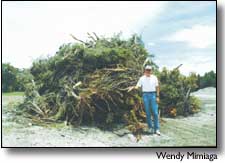|
Nov. 9, 2000 By Tom Vaughan
The Mesa Verde National Park Fire Management Plan is on the shelf at the Mancos Public Library, available for public review in the building. This is the written policy that was in effect through the Bircher and Pony fires of last July and August. As the governing policy for managing wildland fires at Mesa Verde, the plan states both the agency and the park-specific objectives for the program. In addition to detailed descriptions of the organization and operation of the parkís fire-management program, the plan contains insights into the recent fire history of Mesa Verde. The vast majority of fires in the park are caused by lightning, as were the Bircher and Pony fires. This summerís conflagrations occurred, according to the plan, during the most common time of the year for such fires: "Lightning, responsible for 94 percent of Mesa Verde fires, is two to three times more prevalent from mid-July to mid-August than in June." Appendix Dís fire-by-fire summary of fires from Sept. 1, 1926, to Oct. 2, 1997, shows that only 38 of the 600 fires recorded were human-caused and that proportion has been going down in recent years. Most of the fires are also very small, according to data in the plan. More than 94 percent of the fires (567) burned a quarter-acre or less; only 1 percent (six fires) burned more than 300 acres. The fire history also reveals an increase in both number and size of fires over the 71-year period recorded. In the 10 years from 1927 through 1936, there were only 16 lightning fires and seven human-caused fires, which burned a total of 2,257.6 acres. By comparison, the years 1987 through 1996 were recorded as experiencing 248 lightning fires and eight human-caused fires, with 7,431.3 acres scorched ó more than 11 times the total number of fires in the earlier period, with over three times as many acres burned. On page 19, the planís authors speculate, "(The) reduction in human-caused fire occurrence is probably due to the success of park and national wildfire prevention programs that began in earnest in the 1950s." Ironically, those same programs, with their corresponding emphasis on stamping out all fires immediately, allowed fuel to accumulate, setting the stage for more frequent fires that burn more acres. The 1996 document is in a three-ring binder, making it easy to copy pages of special interest. Later elements also included in the binder are an appendix on Mesa Verdeís fire history and chronology (which includes data into 2000), and a printout of the NPS Directorís Order on wildland fire management, dated Nov. 17, 1998. |
||||
|
Copyright © 2000 the Cortez Journal.
All rights reserved. |
